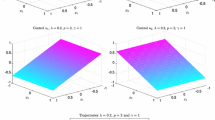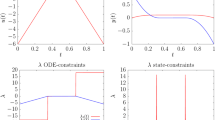Abstract
This paper proposes an efficient computational technique for the optimal control of linear discrete-time systems subject to bounded disturbances with mixed linear constraints on the states and inputs. The problem of computing an optimal state feedback control policy, given the current state, is non-convex. A recent breakthrough has been the application of robust optimization techniques to reparameterize this problem as a convex program. While the reparameterized problem is theoretically tractable, the number of variables is quadratic in the number of stages or horizon length N and has no apparent exploitable structure, leading to computational time of \({\mathcal{O}}(N^{6})\) per iteration of an interior-point method. We focus on the case when the disturbance set is ∞-norm bounded or the linear map of a hypercube, and the cost function involves the minimization of a quadratic cost. Here we make use of state variables to regain a sparse problem structure that is related to the structure of the original problem, that is, the policy optimization problem may be decomposed into a set of coupled finite horizon control problems. This decomposition can then be formulated as a highly structured quadratic program, solvable by primal-dual interior-point methods in which each iteration requires \({\mathcal{O}}(N^3)\) time. This cubic iteration time can be guaranteed using a Riccati-based block factorization technique, which is standard in discrete-time optimal control. Numerical results are presented, using a standard sparse primal-dual interior point solver, that illustrate the efficiency of this approach.
Similar content being viewed by others
References
Anderson B.D.O. and Moore J.B. (1990). Optimal control: linear quadratic methods. Prentice-Hall, Inc., Upper Saddle River
Bemporad, A.: Reducing conservativeness in predictive control of constrained systems with disturbances. In: Proceeding 37th IEEE conference on decision and control, pp. 1384–1391. Tampa, FL, USA (1998)
Bemporad A., Borrelli F. and Morari M. (2003). Min-max control of constrained uncertain discrete-time linear systems. IEEE Trans. Autom. Control 48(9): 1600–1606
Bemporad A. and Morari M. (1999). Robust model predictive control: a survey in robustness in identification and control. In: Garulli, A., Tesi, A. and Vicino, A. (eds) Lecture notes in control and information sciences, vol. 245., pp 207–226. Springer, Berlin
Ben-Tal A., Boyd S. and Nemirovski A. (2006). Extending scope of robust optimization: comprehensive robust counterparts of uncertain problems. Math. Program. 107(1–2): 63–89
Ben-Tal A., Goryashko A., Guslitzer E. and Nemirovski A. (2004). Adjustable robust solutions of uncertain linear programs. Math. Program. 99(2): 351–376
Bertsekas D.P. and Rhodes I.B. (1973). Sufficiently informative functions and the minimax feedback control of uncertain dynamic systems. IEEE Trans. Autom. Control AC-18(2): 117–124
Biegler, L.: Efficient solution of dynamic optimization and NMPC problems. In: Allgöwer, F., Zheng, A. (eds.) Nonlinear model predictive control, progress in systems and control theory, vol. 26, pp. 219–243. Birkhäuser (2000)
Blanchini F. (1999). Set invariance in control. Automatica 35(1): 1747–1767
Boyd S. and Vandenberghe L. (2004). Convex optimization. Cambridge University Press, Cambridge
Bunch J.R., Kaufman L. and Parlett B.N. (1976). Decomposition of a symmetric matrix. Numerische Mathematik 27: 95–110
Camacho E.F. and Bordons C. (2004). Model predictive control, 2nd edn. Springer, London
Chisci L., Rossiter J.A. and Zappa G. (2001). Systems with persistent state disturbances: predictive control with restricted constraints. Automatica 37(7): 1019–1028
Dahleh M.A. and Diaz-Bobillo I.J. (1995). Control of uncertain systems. Prentice Hall, Englewood Cliffs
Diehl M. and Björnberg J. (2004). Robust dynamic programming for min-max model predictive control of constrained uncertain systems. IEEE Trans. Autom. Control 49(12): 2253–2257
Diehl M., Bock H.G. and Schlöder J.P. (2005). A real-time iteration scheme for nonlinear optimization in optimal feedback control. SIAM J. Optim. 43(5): 1714–1736
Dirske S.P. and Ferris M.C. (1995). The PATH solver: A non-monotone stabilization scheme for mixed complementarity problems. Optim. Methods Softw. 5: 123–156
Duff I., Erisman A. and Reid J. (1986). Direct methods for sparse matrices. Oxford University Press, Oxford
Dullerud G.E. and Paganini F. (2000). A course in robust control theory: a convex approach. Springer, New York
Dunn J.C. and Bertsekas D.P. (1989). Efficient dynamic programming implementations of Newton’s method for unconstrained optimal control problems. J. Optim. Theory Appl. 63(1): 23–38
Fialho I.J. and Georgiou T.T. (1997). ℓ1 state-feedback control with a prescribed rate of exponential convergence. IEEE Trans. Autom. Control 42(10): 1476–81
Fletcher R. (1987). Practical methods of optimization, 2nd edn. Wiley-Interscience, New York
Garstka S.J. and Wets R.J.B. (1974). On decision rules in stochastic programming. Math. Program. 7: 117–143
Gertz E.M. and Wright S.J. (2003). Object-oriented software for quadratic programming. ACM Trans. Math. Softw. 29: 58–81
Gondzio J. (1996). Multiple centrality corrections in a primal-dual method for linear programming. Comput. Optim. Appl. 6: 137–156
Goulart, P.J.: Affine Feedback Policies for Robust Control with Constraints. Ph.D. thesis, University of Cambridge (2006). Available at http://www-control.eng.cam.ac.uk
Goulart PJ, Kerrigan E.: A convex formulation for receding horizon control of constrained discrete-time systems with guaranteed ℓ2 gain. In: Proceeding 45th IEEE conference on decision and control and 2005 European control conference (2006)
Goulart P.J., Kerrigan E.C. and Maciejowski J.M. (2006). Optimization over state feedback policies for robust control with constraints. Automatica 42(4): 523–533
Green M. and Limebeer D.J.N. (1995). Linear Robust Control. Prentice Hall, Englewood Cliffs
Guslitser, E.: Uncertainty-immunized solutions in linear programming. Master’s thesis, Technion, Israeli Institute of Technology (2002)
van Hessem, D.H.: Stochastic inequality constrained closed-loop model predictive control. Ph.D. thesis, Technical University of Delft (2004)
van Hessem, D.H., Bosgra, O.H.: A conic reformulation of model predictive control including bounded and stochastic disturbances under state and input constraints. In: Proceeding 41st IEEE conference on decision and control, pp. 4643–4648 (2002)
Horn R. and Johnson C. (1985). Matrix analysis. Cambridge University Press, Cambridge
HSL: HSL 2002: A collection of Fortran codes for large scale scientific computation. http://www.cse.clrc.ac.uk/nag/hsl (2002).
Jacobson D. and Mayne D. (1970). Differential dynamic programming. Elsevier, New York
Kerrigan, E.C., Alamo, T.: A convex parameterization for solving constrained min-max problems with a quadratic cost. In: Proceeding 2004 American control conference, pp. 2220–2221. Boston, MA, USA (2004)
Kerrigan, E.C., Maciejowski, J.M.: On robust optimization and the optimal control of constrained linear systems with bounded state disturbances. In: Proceeding 2003 European control conference. Cambridge, UK (2003)
Lee Y.I. and Kouvaritakis B. (1999). Constrained receding horizon predictive control for systems with disturbances. Int. J. Control 72(11): 1027–1032
Löfberg, J.: Approximations of closed-loop MPC. In: Proceeding~42nd IEEE conference on decision and control, pp. 1438–1442. Maui, Hawaii, USA (2003)
Löfberg, J.: Minimax approaches to robust model predictive control. Ph.D. thesis, Linköping University (2003)
Maciejowski J.M. (2002). Predictive control with constraints. Prentice Hall, UK
Mayne D.Q. (2001). Control of constrained dynamic systems. Eur. J. Control 7: 87–99
Mayne D.Q., Rawlings J.B., Rao C.V. and Scokaert P.O.M. (2000). Constrained model predictive control: stability and optimality. Automatica 36(6): 789–814
Mayne D.Q., Seron M.M. and Raković S.V. (2005). Robust model predictive control of constrained linear systems with bounded disturbances. Automatica 41(2): 219–24
Qin S.J. and Badgwell T.A. (2003). A survey of industrial model predictive control technology. Control Eng. Practice 11: 733–764
Rao C.V., Wright S.J. and Rawlings J.B. (1998). Application of interior–point methods to model predictive control. J. Optim. Theory Appl. 99: 723–757
Scokaert P.O.M and Mayne D.Q. (1998). Min-max feedback model predictive control for constrained linear systems. IEEE Trans. Autom. Control 43(8): 1136–1142
Scokaert P.O.M and Rawlings J.B. (1999). Feasibility issues in linear model predictive control. AIChE J. 45(8): 1649–1659
Shamma J.S. (1996). Optimization of the ℓ∞-induced norm under full state feedback. IEEE Trans. Autom. Control 41(4): 533–44
Stein G. (2003). Respect the unstable. IEEE Control Syst. Magaz. 34(4): 12–25
Steinbach, M.C.: Fast recursive SQP methods for large-scale optimal control problems. Ph.D. thesis, University of Heidelberg (1995)
Sznaier M. and Bu J. (1998). Mixed ℓ1/H ∞ control of MIMO systems via convex optimization. IEEE Trans. Autom. Control 43(9): 1229–1241
Witsenhausen H.S. (1968). A minimax control problem for sampled linear systems. IEEE Trans. Autom. Control AC-13(1): 5–21
Wright S.J. (1993). Interior point methods for optimal control of discrete-time systems. J. Optim. Theory Appl. 77: 161–187
Wright S.J. (1997). Primal-dual interior-point methods. SIAM Publications, Philadelphia
Youla D.C., Jabr H.A. and Bongiorno J.J. (1976). Modern Weiner-Hopf design of optimal controllers: Part II. IEEE Trans. Autom. Control AC-21: 319–338
Zames G. (1981). Feedback and optimal sensitivity: Model reference transformations, multiplicative seminorms and approximate inverses. IEEE Trans. Autom. Control AC-26(2): 301–320
Zhou K., Doyle J., Glover K. (1996) Robust and optimal control. Prentice-Hall, Englewood Cliffs
Author information
Authors and Affiliations
Corresponding author
Rights and permissions
About this article
Cite this article
Goulart, P.J., Kerrigan, E.C. & Ralph, D. Efficient robust optimization for robust control with constraints. Math. Program. 114, 115–147 (2008). https://doi.org/10.1007/s10107-007-0096-6
Received:
Accepted:
Published:
Issue Date:
DOI: https://doi.org/10.1007/s10107-007-0096-6




